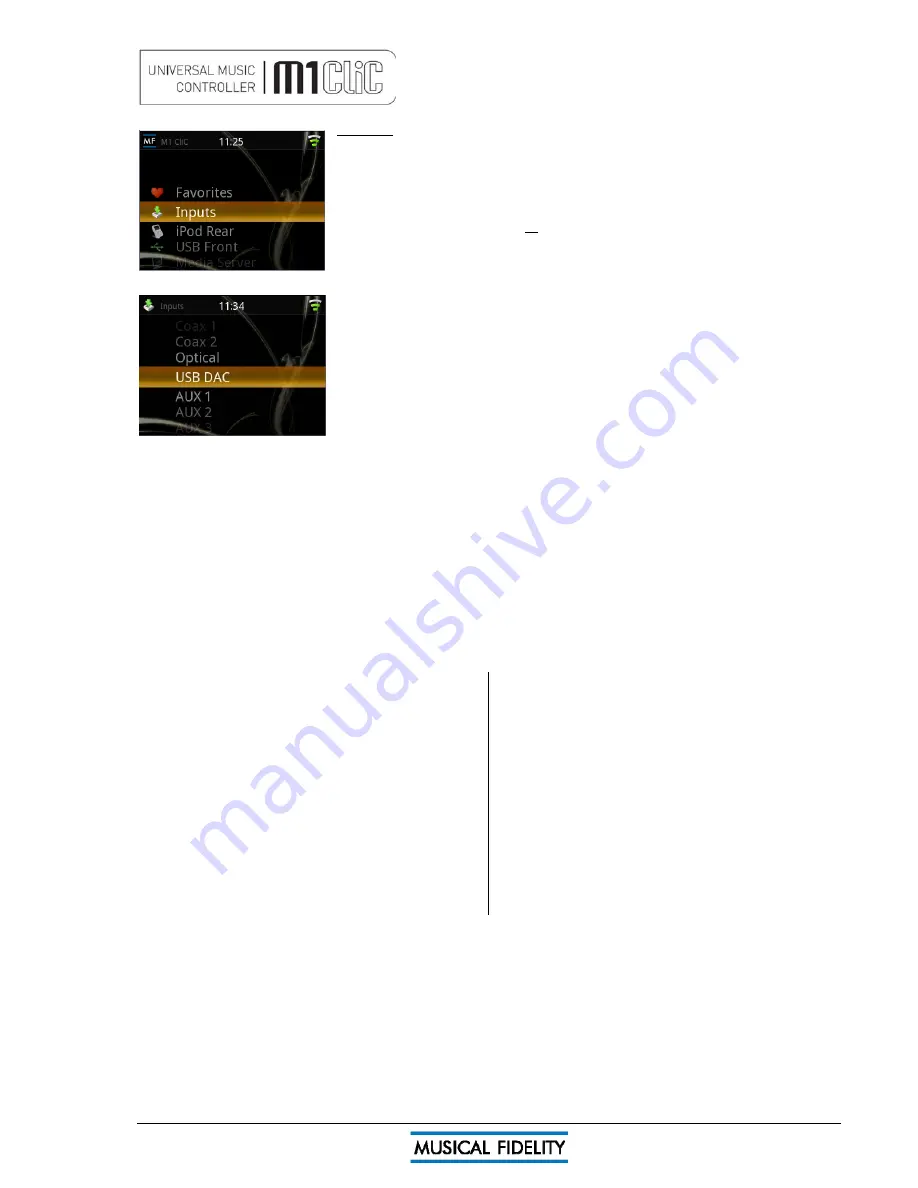
M1 CLiC issue 5
Page 17 of
24
INPUTS.
There are seven inputs available for other sources of audio:
Coax 1
,
Coax 2
and
Optical
are all digital inputs for stereo (2-channel) digital
sources such as CD, Minidisk, DAT or TV set top boxes. Please note that any
connected TV or home theatre related equipment including set top boxes
must
be set up to output a 44.1kHz
or
48kHz
PCM STEREO
digital stream or similar.
The M1 CLiC
does not
recognize multi channel digital audio.
USB DAC
is for direct connection to a computer to playback computer audio
with the M1 CLiC acting like a high-quality external computer soundcard. The
audio in this case is controlled by the COMPUTER not the M1 CLiC.
AUX1
,
AUX2
and
AUX3
are inputs for legacy analogue-output Hifi separates
such as tape decks, phono cartridge preamplifiers, etc..
At the
Main Menu
first select
Inputs
using the OK button on the remote.
Using navigation keys, on the remote, scroll up or down the list of options and
select the input required using the OK button. The selected input is then ready
for use.
USB DAC input notes
A good quality USB A to B cable is required to connect the USB DAC input to the computer.
Plug the B (square) end into the socket in the back of the unit, and the A (rectangle) end into a free USB socket
on the computer.
The computer should now detect the new hardware and install the driver automatically (No setup or driver disk
is required).
CD, MP3, WAV, AAC, FLAC, and all other audio file types played on any software should now play through the
unit. This device has been designed to work with PC Windows 98, ME, 2000, XP, Vista and 7, as well as Apple
Macintosh OS X, Snow Leopard and later.
Other Operating systems may have proprietary drivers built-in or available. Please contact the operating
system publisher or support for more details.
Please note Musical Fidelity do not provide
any
drivers for any operating system for the USB interface.
PC users-
Check the computer has picked up the device and
is currently using it by clicking: (most Windows
versions)
- Start
- Settings
- Control panel
- Sounds and Multimedia
- Audio
Check that “USB audio device” appears under
PREFERRED AUDIO DEVICE tab
A second mixer will now be available which will be
the default mixer whenever the unit is plugged in.
Use this mixer to select the source or adjust levels if
required.
Mac users-
Check the computer has picked up the device and
is currently using it by clicking: (MAC OS X)
- System preferences
- Hardware
- Sound
Check that “USB audio DAC” is selected under the
OUTPUT tab.
If the computer’s warning sounds/chimes are to
played through the unit, make sure it is selected
under the
SOUND EFFECTS tab too.
Note: USB may also be selected as an output in
some individual programs.
Please note: This device is a high speed serial data processor, and by its nature, requires a very high volume of
USB band width. It will benefit greatly from being the only device connected on its USB ‘bus’. Sharing the same
bus with other devices may cause unwanted artifacts such as dropouts or temporary loss of signal. This
especially includes the use of the unit on a USB hub/splitter alongside other USB components
Please note: This device is a high speed serial data processor, and by its nature, requires a very high volume of
USB band width. It will benefit greatly from being the only device connected on its USB ‘bus’. Sharing the same
bus with other devices may cause unwanted artifacts such as dropouts or temporary loss of signal. This
especially includes the use of the unit on a USB hub/splitter alongside other USB components.
Inputs






















